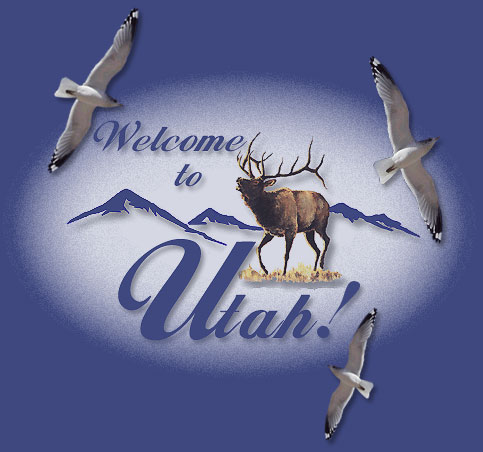

Today we leave the comfort of our air-conditioned tour bus for the open-air, ox-drawn Conestoga wagon as we join the sons and daughters of the Utah Pioneers in celebrating their annual Pioneer Days. (With our apologies to our Finest Utah FRiends for arriving a day late.)

"Pioneer Day" - July 24
Pioneer Day in Utah, a state holiday, is recognized by the Mormons as the day they entered into Utah Valley (what is now called Salt Lake City) on July 24, 1847. It was on that day, the President of the Church, Brigham Young, pronounced from a nearby mountain top "This is the place". Along with Brigham Young were 143 men, 3 women, and 2 children that entered into the uninhabited Salt Lake Valley.
The Mormon Trail
From 1846 to 1869, more than 70,000 Mormons traveled along an integral part of the road west, the Mormon Pioneer Trail. The trail started in Nauvoo, Illinois, traveled across Iowa, connected with the Great Platte River Road at the Missouri River, and ended near the Great Salt Lake in Utah. Generally following pre-existing routes, the trail carried tens of thousands of Mormon emigrants to a new home and refuge in the Great Basin. From their labors arose the State of Deseret, later to become the Utah Territory, and finally the State of Utah.
PACKIN' THE WAGON
Many pioneers overestimated the amount of cargo they could haul. As the long journey weakened and wearied the oxen, loads were lightened. Such heirlooms as prized furniture, book collections, china, and pianos were often abandoned along the trail. Sometimes precious items were left along the trail with the hope of picking them up at a later date. Such was the case with the Kimball family in 1847. As they approached the mountains, they unloaded their piano...... (shown below)
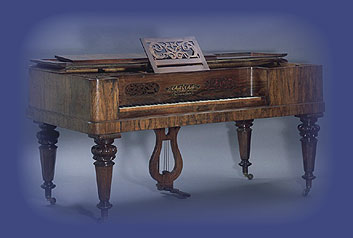 ......dug a large hole, wrapped the piano in buffalo skins, carefully placed it in the hole, and then covered it with dirt. The following spring an ox team transported it to Salt Lake City. ......dug a large hole, wrapped the piano in buffalo skins, carefully placed it in the hole, and then covered it with dirt. The following spring an ox team transported it to Salt Lake City.
~~~~~~~~~~~~~~~~~~~~~~~~~~~~~~~~~~~~~~~~
The "Nauvoo Neighbor" suggested the
following list of provisions every
family wagon should have:
1 good strong wagon, well covered with a light box
2 or 3 good yoke of oxen between the age of 4 and 10 years
2 or more milk cows
1 or more good beeves
3 sheep if they can be obtained
1000 lbs. of flour or other bread or bread stuffs in good sacks
1 good musket or rifle to each male over the age of 12 years
1 lb. powder
4 lbs. lead
1 lb. tea
5 lbs. coffee
100 lbs. sugar
1 lb. cayenne pepper
2 lbs. black pepper
1/2 lb. mustard
10 lbs. rice for each family
1 lb. cinnamon
1/2 lb. cloves
Cooking utensils to consist of a bake kettle, frying pan, coffee pot, and tea kettle
Tin cups, plates, knives, forks, spoons, and pans as few as will do
A good tent and furniture to each 2 families |
. |
. |
. |
1 doz. nutmegs
25 lbs. salt
5 lbs. saleratus
10 lbs. dried apples
1/2 bushel of beans
A few lbs. of dried beef or bacon
5 lbs. dried peaches
20 lbs. dried pumpkin
25 lb. seed grain
1 gal. alcohol
20 lbs. of soap each family
4 or 5 fish hooks and line
15 lbs. iron and steel
A few lbs. of wrought nails
One or more sets of saw
or grist mill irons to company of 100 families
2 sets of pully blocks and ropes to each company for crossing rivers
1 good seine and hook for each company
From 25 to 100 lbs. of farming and mechanical tools
Clothing and bedding to each family not to exceed 500 pounds
Ten extra teams for each company of 100 families |
The key to surviving the westward trek
was to take enough but not too much.
~~~~~~~~~~~~~~~~~~~~~~~~~~~~~~~~~~~~~~~~
They traveled by the tens of thousands in creaking wagons, by horseback, and on foot. Many made the 1,297-mile westward trek on foot, pulling 500 pounds of provisions and belongings in rickshaw-like handcarts. They built bridges. They braved unforgiving weather and fought disease. They buried their dead along the way. They were the Mormon people and in 1847 they began the greatest organized mass migration of a single group in America's history, to a place of refuge and religious freedom in Salt Lake City, Utah.
These are the men, women and children who built a community that grew into Salt Lake City, now a beautiful, bustling metropolis.
Salt Lake City is, among
many other things, the....
home of The Church of Jesus Christ of Latter-Day Saints,
the world famous Mormon Tabernacle Choir,
and was the host city for the 2002 Olympic Winter Games.
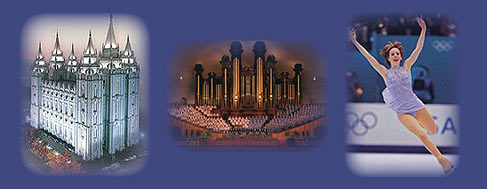
Today we give a Finest salute to the brave
pioneers who ventured west and settled
in the Utah Valley ~ and to their sons and
daughters who keep the pioneer spirit alive.
Utah's State Symbols
Utah has more state symbols than any state I have profiled to date. They are seriously into their symbols, LOL, and they have a few surprising ones. Who would have thought that the California Gull (Larus californicus), would be the state bird of Utah? Apparently even the seagulls are leaving California! ;-)
The reason for this choice for state bird is probably in commemoration of the fact that these gulls saved the people of the State by eating up the Rocky mountain crickets which were destroying the crops in 1848.
Orson F. Whitney says that in the midst of the devastation of the crickets, "when it seemed that nothing could stay the devastation, great flocks of gulls appeared, filling the air with their white wings and plaintive cries, and settled down upon the half-ruined fields. fields. All day long they gorged themselves, until the pests were vanquished and the people were saved. After devouring the crickets, the gulls returned to the lake islands whence they came."
Along with the standard state symbols; flower- the Sego Lily, symbol - Beehive, and animal - the Rocky Mountain Elk, are the state "cooking pot" - the Dutch oven, the state "fossil" - the Allasourus and the state "historic vegetable" - the sugar beet. Each of these symbols carry with them a story of Utah's rich history. Click HERE to learn more.
~~~~~~~~~~~~~~~~~~~~~~~~~~

As with every state I have profiled, Utah cannot be presented in full in just one post. There is so much more about this interesting state than I have been able to present here. I will leave it to you to discover the rest of Utah for yourself. Click on the pictures to learn more about these fascinating points of interest.
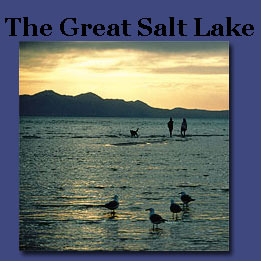
The Great Salt Lake occupies 2,500 square miles
northwest of Salt Lake City, but it was once part of
the much larger Lake Bonneville, which 18,000
years ago extended across 20,000 square miles
including parts of Idaho and Nevada.
10 Common Myths
about the Great Salt Lake
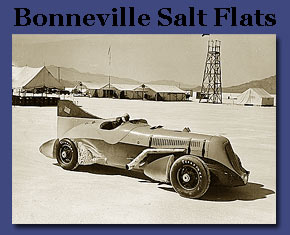 Ab Jenkin's "Mormon Meteor" rolling out to
Ab Jenkin's "Mormon Meteor" rolling out to
begin another speed record attempt, 1931.

Attracting close to 5 million people
annually, Temple Square is Salt Lake's
biggest attraction and one of the major
tourist destinations of the West.
~~~~~~~~~~~~~~~~~~~~~~~~~~
And, last but not least, we offer...
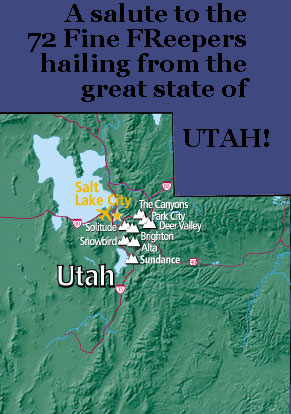
~~~~~~~~~~~~~~~~~~~~~~~~~~
Thanks to the following websites for
providing history and images of Utah....
The Official Utah State Website

The Sons of Utah Pioneers

|
|
|
|

|
|
|
|
|
|

